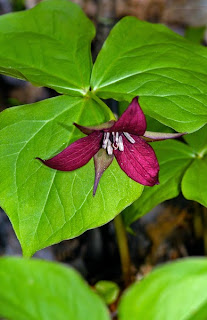The White Trilliums, Trillium grandiflorum, are in full and glorious bloom at Pine Ridge. There are hundreds, all along the driveway, in the woods, and in my garden. They come up in the shady woodland garden, the hillside garden, the rockery and even the herb garden. Clumps, clusters, sweeps and swaths of white all around me.
This coming Sunday is my Trillium Day and I have advertised in the local paper and some other places so I really hope the Trills stay beautiful until then! The rain and cool weather we are having should work in my favour. Naturally, this means that I have Trilliums on my mind - trillium designs on some of the pottery, trillium pictures, trillium conversations on various blogs and groups and lists. There is a Trillium group on Facebook, too, and since it is Trillium season everywhere, the images are coming in thick and fast, each one more beautiful/interesting/amazing/awful than the previous.
I include 'awful' because I am surprised by some of the ignorance and misconceptions out there. On Saturday at the Carp Farmers' Market I had someone tell me very seriously that it was illegal to pick a trillium... this bit of misinformation simply will not go away. NO, it is not illegal to pick a trillium. Or dig a trillium, or step on a trillium, or whatever - assuming it is YOUR trillium. If it is yours, you can do whatever you want to it. Naturally, I don't think you should but you are totally allowed. On the other hand, if you do not own it, you are not allowed to do anything to it other than look at it and maybe photograph or paint it.
Picking or digging or trampling anything in any park, conservation area, ANSI or other protected area in Canada is illegal. Big fines. Nasty glares from people like me. Do not do it. You know that. And remember that all other spaces are private property. Somebody owns every square inch, even if it is only the government or some developer. The roadsides are also owned, by the property owners next to them, although the roads people have rights-of-way. So please do not pick, dig, trample etc. trilliums along the roads! The plants along the roads belong to all of us.
Another big misconception that gets my shirt in a knot is some people think there are white white trilliums and pink white trilliums. Well, yes, there are pink white trilliums, but what is confusing these folks is that all T. grandiflorum flowers turn pink as they age. The variety (or varieties) of T. grandiflorum that actually are pink are a different shade, start out pink, and open pink, on both the fronts and the backs of the petals. They too turn purplish pink as they go over.
You can see the difference in colour: the pink variety, which occurs naturally and is not that uncommon, is a soft rose while the colour of a fading White Trillium is a more strident, bluer pink. There are varieties, found originally in the US south of us, that are deeper rose than the one here. To my knowledge, it is not available in Canada.
And just to clear up another confusion, there is also a different local species of Trillium, T. erectum, with red or maroon flowers:
I could hardly believe my ears when I heard it described as 'the pink Trillium'. Pinkish red, maybe, but 'pink'? No, dear overheard person, this is a different species.
There are some 40 accepted species of Trilliums, and a few possible ones. There is much study being done right now so this will likely change in the next few years. In our area we have only 4 native species: T. grandiflorum, the Great White, T. cernuum, the Nodding, T. erectum, the Red, and T. undulatum, the Painted. Quite a few other ones are hardy here. I have T. luteum, T. recurvatum, T. cuneatum, T. viridescens, and T. flexipes and they are doing well.
Much confusion exists around the concept of double flowers in Trillium. Here are four different forms:
And there are others. The one that seems the most common in the nursery trade, called 'Snow Bunting' is like the one in the lower left corner, but a lot more 'ball' shaped. The 4-leaved flower is not really a double. Flowers like this one are more likely the result of bud damage to the growing shoot and will likely not appear the following year. It's fun to find 'quadrillions', but they aren't really rare, and they aren't often attractive. This one is, and the plant has had those flowers for some years now.
Unfortunately, this is not a new and unusual flower form. It is most likely the result of a virus infection. In some patches there may be a number of flowers with green areas, and the infection often seems to spread.
Sometimes the plant or plants will eventually succumb, other times they seem to recover. In any case, these should not be propagated.
Let's end with a picture of some healthy flowers! And if you would like to see lots of them in bloom, come to my Trillium Day on Sunday - details in the sidebar. I'll have some plants for sale as well, and if the weather co-operates, some artist friends will be joining me to show some of their garden-related art.
Happy Trillium Season!







We also have trilliums in our bush - white and red. I have heard that the corms are edible so we joke that if the world goes haywire at least we can eat our trilliums. And our wild garlic, and false Solomon seal and orange daylilies. Could always get a goose or two for meat. So we are all set:)
ReplyDeleteHow lucky to have Trillium growing in your woodland garden. I've been saying for years that I must buy a couple for our woodland but never got round to it. This year I must!
ReplyDelete